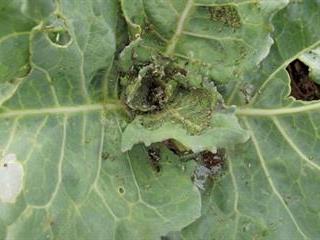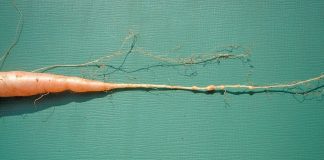
Secondly, they can spread viral diseases. In some cases, these diseases can be more severe than the physical damage. The most common virus is cauliflower mosaic virus, which causes the plants to become paler.
Typically, an infected aphid flies in, often from a distant farm, and occupies a single plant. When there are a large number of aphids, winged adults develop by the thousand and fly off to infect other plants. A single infected plant that goes unnoticed can therefore cause enormous damage to the crop.
Two species – the cabbage aphid and the false cabbage aphid – are likely to attack brassicas. The former is the most common and prefers the cooler season, although it is not confined to it.
Cabbage aphid
These aphids form dense colonies on the leaves and have a distinct waxy grey covering. Their feeding causes the leaves to roll back, which makes them very difficult to control with contact insecticides as the spray cannot reach them.
The feeding also causes white lesions on the leaves, a clear symptom of infestation that remains on the leaves even after the aphids have been controlled.
Be especially vigilant in autumn when this pest starts to become active. Winged aphids fly in and start colonies on the newly transplanted plants, concentrating their activities near the growing tips.
If not treated early, they will become difficult to control; even a boom sprayer may not be effective against the aphids protected by curled leaves.If the aphids have become established in young plants in this way, the most effective way to get rid of them is to use a knapsack sprayer.
Go down each row and, holding the nozzle close to the plant, spray into the plant centre. You need only concentrate on wetting this area; the rest of the plant can be done with the boom sprayer.
With a knapsack sprayer, you can average 50 plants/ minute (this includes the time taken to refill the tank). It is very important to do only one row at a time. It seems logical to go back and forth spraying the rows alongside, but this is inefficient. It slows down the operation and may cause you to miss some of the plants.
False cabbage aphid
This aphid is greenish rather than grey and lacks the waxy coating of the true cabbage aphid. It is also more likely to be prevalent in the warmer months. It is often found on the lower leaves before spreading all over the plant. Because it does not cause the leaves to roll back, it is easier to control. If many aphids are around, apply a drench of imidaclorprid to the seedlings to protect them for an extended period on the land.
Insecticides
The most effective insecticide for aphid control is pirimicarb, a systemic product safe for aphid predators. Once the land has been sprayed, ladybirds and parasitic wasps will seek out any surviving aphids. If you are an organic grower who cannot use these products, keep a careful lookout for aphids. At the first sign of the pest, carry out a thorough spraying with an approved product.
You cannot rely solely on natural predators to control aphids. At best, they will slow down the spread, but they will certainly not eliminate the pest.












